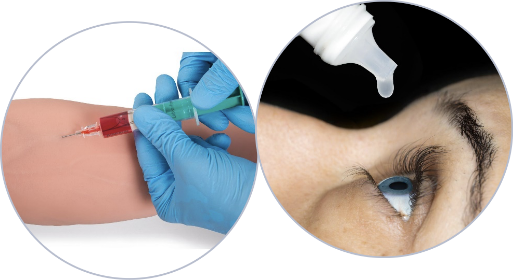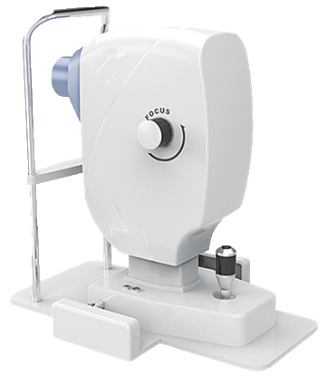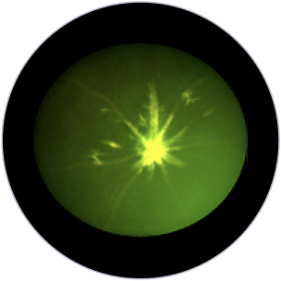Technology
Amydis detects molecular biomarkers in the eye
Accessible, affordable, adoptable, designed to fit the clinical workflow

Amydis patent-protected eye tracer formulated to address different markets.


Use imaging technologies and workflows already established in eye care practices.


Molecular biomarker images captured during office visit to power AI-based insights.

Why the eye?
The eye reveals pathologies that lead to vision loss and offers valuable insights into overall health. The eye provides a non-invasive view of cells connected to the brain, making it a window into neurodegeneration. Eye vasculature provides insights into other vascular organ systems such as the heart. Molecular biomarkers in the eye allow for detection of diseases in the earliest stages possible.
- There will be an increase in demand of eye care providers because of aging and use of digital screens.
- Myopia (near sightedness) is increasing in kids due to use of digital screens; affects 2.6B people.
- Presbyopia (far sightedness) impacts all adults, typical onset in early 40s; affects 1.8B people.
- Baby Boomers/aging population on Medicare are required to have annual eye exam.
- Eye care providers are readily accessible; 90% of the Medicare population lives within 25 minutes of an ophthalmologist and 14 minutes of an optometrist.
Therefore, eye care providers are positioned to become earliest point of healthcare, including becoming healthcare hubs for detecting neurodegenerative and cardiological diseases through the eye.

Why Amydis?
Amydis is a leader in developing ocular tracers to enable breakthrough disease detection and insights.
- Amydis’ first-in-class ocular tracers unlock the opportunity for robust in-vivo labeling of disease-related molecular biomarkers in the eye during routine eye examinations.
- The Amydis tracers are novel small molecule fluorophores that bind selectively to amyloid and amyloid-like deposits of disease-related biomarkers, including those formed by Aβ and α-synuclein.
- Amydis tracers generate a robust signal that can be detected by diagnostic cameras that are routinely used by eye care providers today.
- The addition of ocular molecular biomarker data creates an unprecedented opportunity for breakthrough insights in differential diagnosis, prediction, and prognosis of ophthalmic, neurodegenerative, and cardiological diseases.
- Through extensive scientific rigor and support from the NIH and Michael J Fox Foundation, Amydis has proven that these tracers can accurately detect, label, and quantify molecular biomarkers.
- The Company is currently in human clinical trials.
Why now?
Digital health technology is advancing at an unprecedented speed.
- Non-invasive eye diagnostic imaging devices with the ability to capture high-resolution three-dimensional data in clinical settings are becoming standard of care.
- These devices capture data in seconds to allow clinicians to evaluate structural and vascular biomarkers in the retina related to ophthalmic, neurodegenerative, and cardiological health.
- Molecular biomarkers in the eye are invaluable for the early detection and monitoring of overall health.
- The ability to visualize and analyze molecular biomarkers in the eye accurately, reliably, and precisely is currently not possible in clinical settings.
- Amydis’ ocular molecular biomarker data has the potential to transform healthcare by empowering eye care providers with unprecedented insights to effectively participate in detecting and monitoring early signs of several treatable neurodegenerative and cardiological diseases.


The eye contains molecular biomarkers linked to multiple diseases of the body.


Eye
The molecular biomarker, amyloid beta (Aβ), has been shown to be present in the retina of patients with two neurodegenerative diseases that lead to blindness: glaucoma and age-related macular degeneration.

Heart
The molecular biomarker, transthyretin (TTR), typically detected in systemic organs such as the heart, kidney, and liver, has been shown to be present in the front of the eye of patients with TTR systemic amyloidosis.

Brain
The molecular biomarkers, amyloid beta and alpha synuclein typically detected in the brain, have been shown to present in the retina of patients with Alzheimer’s disease and Parkinson’s disease.

Ophthalmic Diseases
Glaucoma and age-related macular degeneration (AMD) are progressive eye conditions that affect millions of people worldwide. Glaucoma is a leading cause of irreversible blindness in the world and 1 in 10 Americans aged 50 and older have AMD. Both diseases are currently diagnosed and managed using various ophthalmic diagnostic technologies that measure retinal structure and vascular changes. The progression of both diseases has also been linked to the accumulation of amyloid beta in the eye, a molecular biomarker that, if detected and treated, may help physicians implement new therapies to prevent disease onset and progression. However, methods to detect this biomarker in the eye are lacking.
Amydis enables the detection of amyloid beta in the eye, accelerating the development and validation of neuroprotective therapies, including those designed to help clear amyloid beta. With the help of Amydis, the introduction of these therapies would reduce cell damage and protect from disease onset before structural and vascular damage occurs.

Cardiological Diseases
It is increasingly recognized that many cases of heart failure are due to a disease that goes largely undiagnosed, particularly among elderly men and African Americans. This condition, termed “ATTR”, is a form of systemic amyloidosis caused by the misfolding and accumulation of a protein called Transthyretin (TTR). The accumulation of TTR amyloid in heart tissue causes heart failure, which can manifest in many commonly recognized forms such as heart failure with preserved ejection fraction. Recently approved medicines have transformed the treatment of ATTR and its cardiac manifestations. Unfortunately, however, diagnosis of ATTR is lagging far behind due to physician unawareness of the disease and the lack of a reliable and accessible diagnostic test.
Amydis offers a new approach to diagnosing ATTR that will enable early detection of the disease and broader capture of patients who may benefit from new therapeutics. TTR amyloid has been shown to occur in an external ocular tissue called the conjunctiva. Amydis ocular tracer has been shown to label TTR deposits in the conjunctiva, thus providing a potential simple and cost-effective new test that eye care professionals can use to help diagnose ATTR cardiomyopathy sooner in heart failure patients so they can be put on the right treatment. Eye care professionals will also be able to use the Amydis test to detect ATTR in at-risk patients, or as part of a routine age-related testing, to identify patients who should be proactively monitored by a cardiologist.

Neurodegenerative Diseases
The diagnosis of many neurodegenerative diseases is complex, resulting in people at risk of these diseases going through long medical journeys before receiving a definitive diagnosis. This delay causes patients to endure stress and lose precious time that could have been devoted to early treatment when therapies are most effective.
Amydis enables non-invasive detection of multiple molecular biomarkers in the retina that are associated with Alzheimer’s Disease, Amyotrophic Lateral Sclerosis, Cerebral Amyloid Angiopathy, Parkinson’s Disease, and more. With the help of Amydis, eye care providers will be able to use the eye as a “window to the brain” to detect these diseases at early stages, potentially even before symptoms arise. For the first time, eye care providers, which are highly utilized by the general public, will be equipped with a diagnostic to accurately triage patients to specialists for timely intervention while also facilitating precision treatment tailored to each patient. In addition, Amydis facilitates precision mapping of an individual’s disease pathogenesis to potentially enable novel drug development and precise combination treatment strategies.



